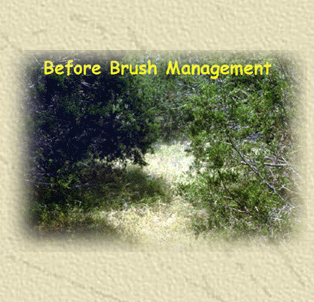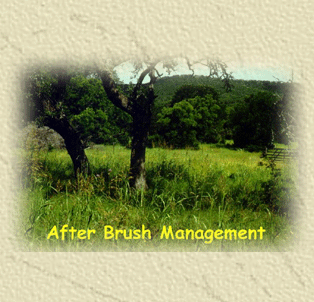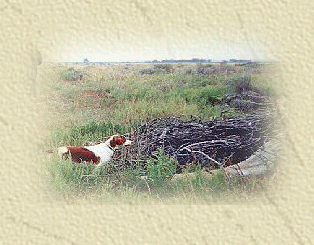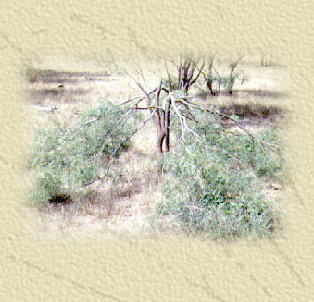|
Range
Management
Management of
the range is the primary tool TWM uses for managing wildlife.
Without proper food,
water, or cover, wildlife species cannot survive. Whether you
are managing for abundant
quail populations, large white-tailed deer or a diversity
of native songbirds, range
management is vital to the success of your goals.
Livestock
Management
Livestock
management means shifting livestock and grazing intensity to
increase
food and animal cover or
to improve a specific animals' habitat. Grazing
management focuses on:
1)
the kind and class of livestock grazed,
2) stocking rates,
3) periodic rest
for pastures by controlling grazing intensity, and/or
4) excluding livestock
from sensitive areas to promote vegetation protection
and recovery or to
eliminate competition for food and cover.
The development of a livestock grazing
plan is specific to your needs as well as
what the habitat will allow.
Fencing
The
installation of a perimeter game fence is a management tool that
we feel
can sometimes assist you
in meeting your goals faster and more efficiently. At
times, this may be the only way
to ensure that your goals will be met. However,
we certainly encourage
neighbors working together in wildlife cooperatives to
meet similar objectives.
Appropriately
designed cross-fencing can play an important role in
grazing
rotation plans. Fencing
also can be used to improve or protect sensitive areas,
woodlands, wetlands,
riparian areas and spring sites. TWM will help you
review your fencing
practices and grazing plans to ensure they meet your overall
wildlife management goals.
Prescribed
Burns
We have found
Prescribed Burning to be one of the most efficient and effective
management tools in range
management in the state of Texas. We have seen few
instances where prescribed
burns, under the right conditions, does not greatly
enhance the habitat.
Prescribed Burns can increase plant diversity, increase food
supplies, act as a natural
fertilizer, control unwanted vegetation, and invigorate
new growth. Contact the
Certified Burn Specialists at TWM to find out how
you can enhance your
property through prescribed burning.
Range
Enhancement
Our main focus
of Range Enhancement primarily deals with establishing native
plants. In
particular, we work with landowners to increase grasses and
forbs
(weeds and wildflowers) on their property that provide food and cover for
wildlife or help control
erosion. Range
enhancement also includes protecting,
restoring and managing native prairies. Our re-seeding mixtures are
appropriate
for the
ecological regions,
soils, and wildlife needs
of your property. Our
mixtures provide a diversity of vegetation on your
property, which in turn,
provides abundant forage for wildlife and/or seed
production the entire year.
Brush
Management
Brush
management may involve maintaining,
establishing or selectively removing or
suppressing
targeted woody plants species to
encourage the growth
of desirable trees, shrubs, grasses and
forbs for forage
and protective cover for selected wildlife species. Brush
management
also includes keeping
the proper kind,
amount and distribution
of woody cover for the particular
species you are interested in.
TWM can
develop a successful brush management plan
that will examine wildlife
cover requirements, soil
types,
potential erosion factors
and will include plans to
control
reinvasion as part of the overall wildlife
management
plan.

Brush piles can provide additional
wildlife cover and
protection in habitats where inadequate
natural cover
limits the growth of a selected
wildlife species.
Planned placement of brush piles and leaving
dead
brush on the ground where it was cut can also protect
seedlings of desirable plant species.

In addition,
stacking posts or limbs in tepees can
provide cover for small game and
other wildlife in
open areas.
Erosion
Control
Erosion
control can come in many forms. Ponds, gully shaping,
riparian
protection, reseeding
areas, as well as typical erosion control structures can
slow
or stop sedimentation from
your land. Other techniques such as brush management
can also help with erosion
control by removing trees and brush and replacing
them with vegetation that
will slow water movement down (grasses).
A
Pond can be a permanent control structure developed to stop or
control
erosion while providing
habitat diversity and benefiting wildlife.
Gully shaping involves reducing erosion rates on severely eroded
areas by
smoothing to acceptable
grades and re-establishing vegetation. We re-seed these
areas with plant species
that provide food and/or cover for wildlife.
Protecting Riparian areas such as streams, ponds, and wetlands allows
native
species to reduce erosion and sedimentation, stabilize the
streambank, improve
plant
diversity and improve the wildlife value of these sensitive areas. Some of
these
activities include:
1)building permanent or temporary
fences to limit livestock grazing,
2)using native hay to slow
and spread water runoff in areas where vegetation,
has been recently
re-established,
3)establishing plant buffer areas or vegetative
filter strips along water
courses,
4)installing rip-rap or other barrier material along embankments to prevent erosion
& protect
wildlife habitat,
5)establishing permanent low
water
crossings to prevent or reduce erosion.
|